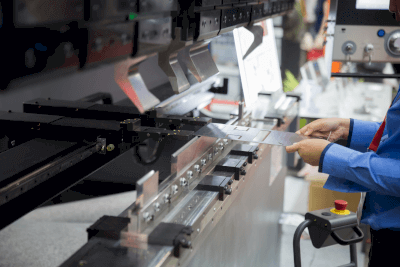What Is Metal Bending?
 Metal bending is the process of bending sheet metal using a die.
Metal bending is the process of bending sheet metal using a die.
Sheet metal is placed in a die that matches the desired shape, and another die is pressed against it to form a bend in the sheet metal. Metal Bendings is a type of bending process.
Most products that use sheet metal, such as desktop computers and other office automation equipment and home appliances such as refrigerators, are formed by sheet metal bending or metal bending. In addition, automobile frames are a typical example of products formed by metal bending.
Metal bending uses a press brake and press work. In press brakes and press processing, sheet metal is inserted between the punch of the upper die and the die of the lower die, and the sheet metal is plastically deformed by applying an external force in the unit of several tons while the punch is lowered.
Uses of Metal Bending
Metal bending is used to form products that are indispensable to our daily lives. For example, office automation equipment such as desktop computers, home appliances such as refrigerators and washing machines, and automobile frames are products made using metal bending.
Most parts that are not seamless and flat, such as welds, bolts, and rivets, are manufactured by metal bending. Elevators are a special case in which colored steel sheets that have been painted from the start are used.
A simple rectangular shape can be fabricated using a bender’s mold, but a specialized shape, such as an automobile, requires a specialized mold. When ordering a prototype, there are cases in which the cost of fabricating the die will depend on the shape of the prototype, and the cost will be higher than that of metal bending for mass-produced products.
Principles of Metal Bending
The basic principle of sheet metal bending is simply to plastically deform sheet metal. By taking advantage of the metal’s irreversible properties (plasticity), an external force is applied to the plastically deformed material to form it.
In metal bending, there is a part where the sheet metal is pushed (inside the sheet metal) and a part where the sheet metal is pulled (outside the sheet metal). Compressive stress occurs on the inside of the sheet metal and tensile stress occurs on the outside of the sheet metal, which can cause cracking if the sheet metal is thin.
To prevent cracks from occurring in metal bending, it is necessary to use a more ductile material.
Types of Sheet Metal Bending
There are eight main types of metal bending. Although the principles of metal bending are the same, the applications differ depending on the product to be manufactured.
Each processing method is as follows:
1. Bottoming
This is a bending processing method in which the upper die is pressed into the V-shaped lower die. It is also called bottom butt bending. When we generally speak of bending, we are referring to bottoming.
2. Coining
Compared to bottoming, coining is a method in which the top of the upper die is pressed with higher pressure to bite into the material. Accuracy is better than that of bottoming, but wear and tear on the die is more severe.
Therefore, metal bending with long bending widths is difficult to be processed by coining.
3. Radius Bending
This method uses a die with rounded corners and the required diameter. This method is used in areas where design is a concern, and is a processing method to create a curved radius shape.
4. Feed Bending
This method uses a V-shaped die to perform R-bending. The corners are rounded. Generally, a press is used as the processing machine.
5. Roll Bending
This method uses a roll bender to create a cylindrical shape by inserting a plate between three rotating rolls. The position of the rolls determines the size of the arc.
6. Step Bending
Also called Z-bending, this method bends sheet metal into a staircase shape. The metal fittings used in the process are specially called stepped bending metal fittings.
7. Hem Bending
This is a processing method in which the edge of sheet metal is folded back. It has the advantage of increasing strength as well as preventing burrs on the edge from touching the operator’s hand at the same sheet thickness.
8. Free Bending
This is a processing method in which the bending angle can be adjusted to any desired one. The sheet metal does not contact the V-shaped lower die on the surface, and the bending angle can be freely determined.
Since the accuracy of bending is lower, high technical skills are required depending on the desired accuracy.